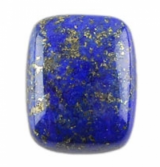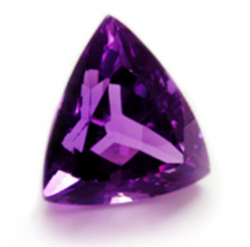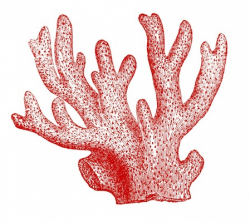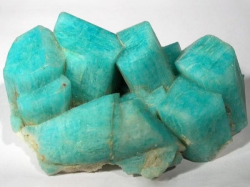What's the meaning of the Lapis Lazuli »
Lapis Lazuli
This page is about the meaning, origin and characteristic of the symbol, emblem, seal, sign, logo or flag: Lapis Lazuli.

Like many gemstones, lapis lazuli possesses a number of different symbolic meanings.
Lapis lazuli is a powerful indicator of ancient long-distance trade. For many centuries, one of the only sources of the gem was the Sar-e-sang mines, located in the Badakhshan Province of northeastern Afghanistan. There is both archaeological and literary evidence that lapis from this area was known in Mesopotamia (roughly analogous to modern-day Iraq) and Egypt thousands of years before the birth of Christ.
The original Latin term used for this gemstone was "sapphirus", and this led to a confusion between lapis lazuli and the mineralogically unrelated sapphire. A prominent example of this confusion is the Old Testament; in early translations of the text, sapphires are mentioned many times, but since that stone was uncommon - if not completely unknown - in the Middle East at the time the scriptures were composed, modern scholars have interpreted these references as lapis lazuli, which was widely known at the time.
The symbolic meaning of lapis lazuli doesn’t require too imagination; with its deep blue color and flecks of golden pyrite, the gem has always been an emblem of the heavens, specifically the starry night sky. The goddess Ishtar, one of the most important deities of ancient Mesopotamia, was the queen of the heavens and frequently associated with lapis lazuli. In some texts, she is described as wearing multiple pieces of jewelry made from the stone. The ancient Egyptians also associated lapis lazuli with the heavens and used it to create charms and amulets. They also ground the stone into powder and used it to create pigment for make-up.
Lapis lazuli’s use as a pigment reached a high point during the European Renaissance, where paint made from the ground stone was the choice color to depict the robes of the Virgin Mary. The use of lapis lazuli symbolized for Mary very much the same thing it symbolized for Ishtar; a position as queen of the heavens.
- 1,399 Views
Graphical characteristics:
Asymmetric, Closed shape, Colorful, Contains both straight and curved lines, Has no crossing lines.
Categories: Gemstones and Natural Substances, Miscellaneous.
More symbols in Gemstones and Natural Substances:
In addition to plants, animals, and geographic features and phenomena, the natural world is home to a vast array of materials and substances that all carry symbolic meaning. This meaning may be rathe… read more »
More symbols in Miscellaneous:
Symbols without any special category attribution but that are widely used worldwide. read more »
Citation
Use the citation below to add this symbol to your bibliography:
Style:MLAChicagoAPA
"Lapis Lazuli." Symbols.com. STANDS4 LLC, 2024. Web. 24 Apr. 2024. <https://www.symbols.com/symbol/lapis-lazuli>.













Have a discussion about Lapis Lazuli with the community:
Report Comment
We're doing our best to make sure our content is useful, accurate and safe.
If by any chance you spot an inappropriate comment while navigating through our website please use this form to let us know, and we'll take care of it shortly.
Attachment
You need to be logged in to favorite.
Log In